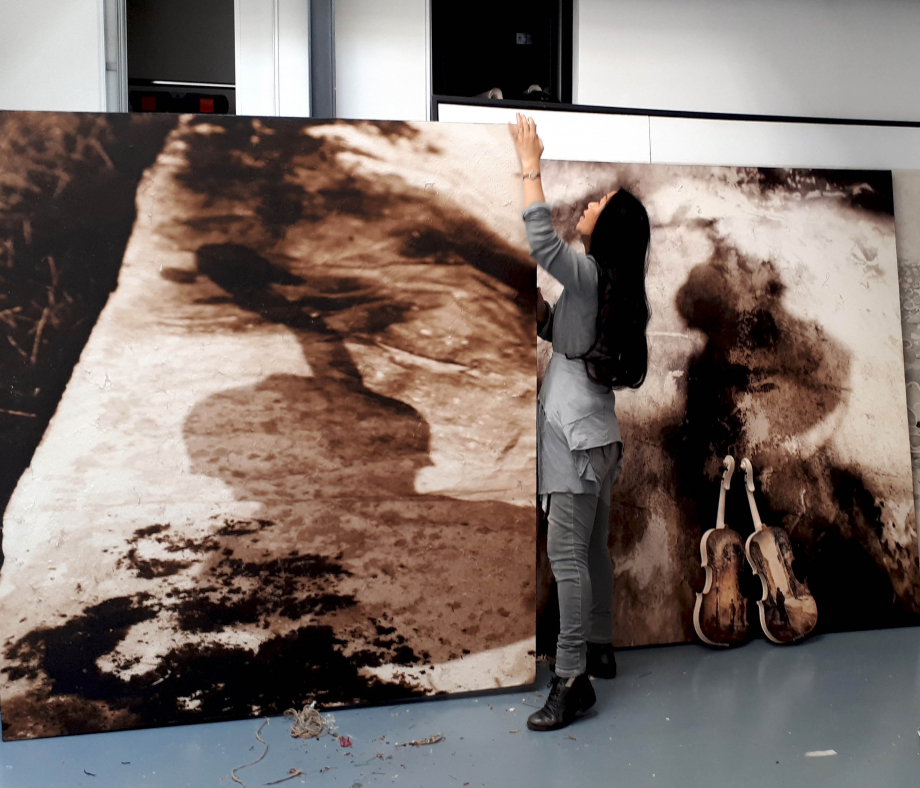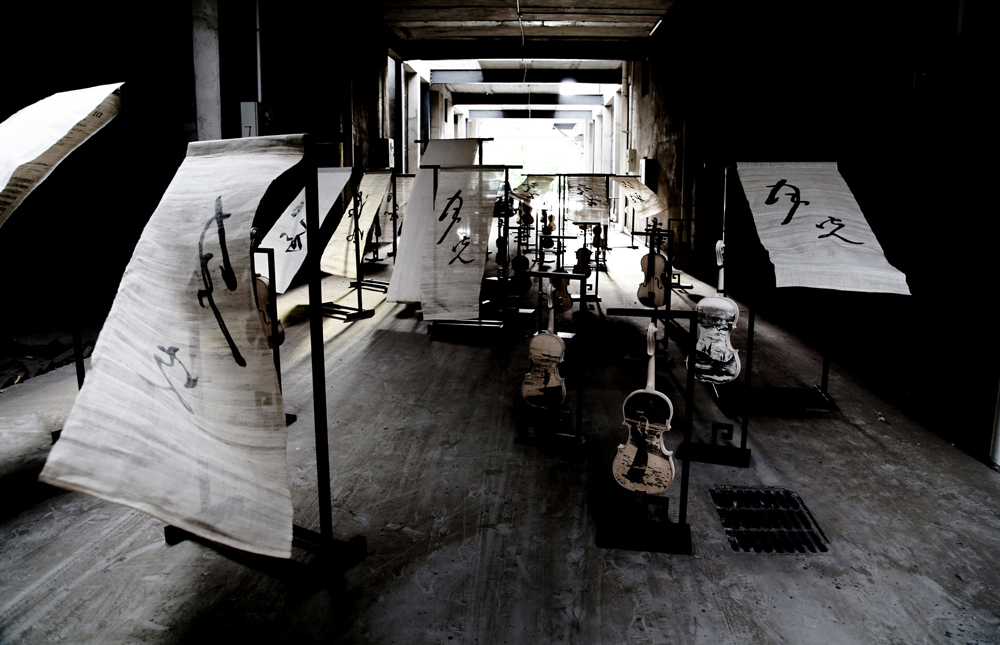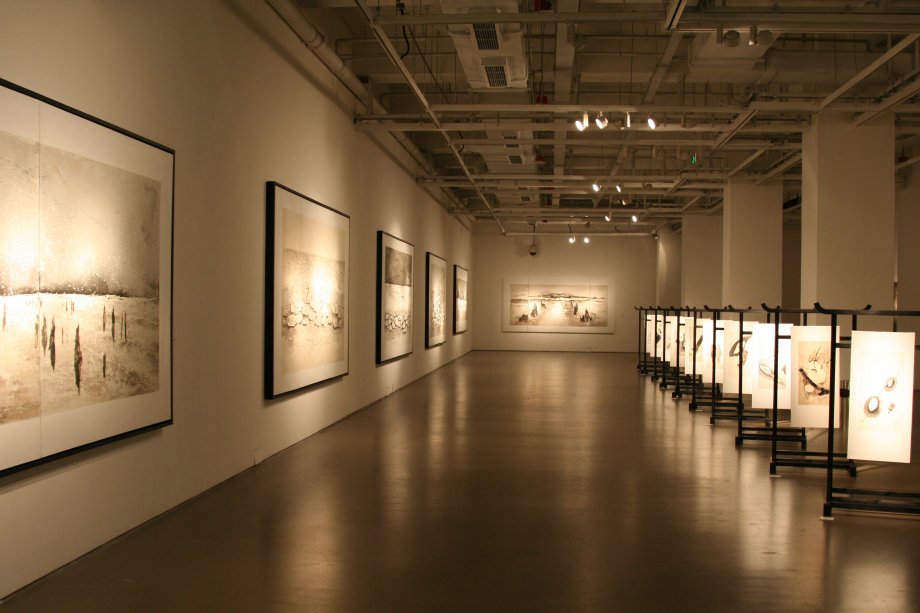LI CHEVALIER INTERVIEW
ASIAN CONTEMPORARY ART
Li Chevalier was born in 1961 in Beijing, China. She uses a mixed technique in her works, mixing the technique of Chinese ink with the Western support that is canvas. Between abstract and figurative art, she transposes her philosophical and existentialist reflections into her paintings.
What was your relationship with art during your childhood?
I grew up during the Cultural Revolution, which began in 1966. The atmosphere of the so-called cultural revolution turned primarily against the intellectuals and the culture they represented : all the cultural heritage of the past had to be destroyed, and any Western influence had to be squeezed out. Thus, the wife of President Mao eliminated all the repertoire of the old Opera. It was replaced by eight revolutionary operas, which looped every day on television and radio. We lived in a sort of cultural « monody », characterized by a unique thought, a unique voice. The country was no longer producing, and the people helped by creating shows to sing the glory of the Party and Mao. Music, singing, dancing and performances were a big part of everyday life. As a child, I felt a real fascination for these operas, which I dreamed of being part of. At the same time, I took drawing and ink painting classes with a lot of diligence and passion. In 1976, at the age of 15, I was recruited by the army to sing. The same year, Mao passed away and the reform began: the country opened, and opened culturally. Gradually, the university also opened, with the possibility to follow graduate studies. I then left the army after 5 years of work and I took the entrance examination test of the university. I succeeded, despite my loss of high school years, to integrate the University of Economic Relations and International Business in Beijing, which trained future officials of the Ministry and various embassies. I was not interested in international finance courses and I spent my time singing and collecting books of philosophy and foreign literature, which were banned during the cultural revolution and reissued at that time. In this university, I had access to international journals and courses given by foreign teachers in English. It was a window to the world. The university offered me this opportunity to expand my vision of the world. You came to France to study political sciences and philosophy.
What encouraged you to study art afterwards?
The 4 years of studies at Sciences Po and the postgraduate degree in political philosophy gave me the opportunity to develop my critical thinking. I went there because I was looking for answers to my personal questions. In parallel to my studies, I sang in the Orchestre de Paris. Knowing that I could not pursue a career as a great vocalist in Europe because of the singing style that I had been taught in China, too different from this one, I turned to my second interest: painting and drawing. Tell us about your beginnings as an artist. In 1990, I discovered the city of Venice in Italy. I met many painters: it shook me. Italy had a key role in my career, for the richness of its images and the artistic heritage of the country that stunned me. I made regular trips to Venice and then to Firenze. In Siena, I met a Dominican priest of the Basilica; I then started Italian language courses and drawing classes. The first years of my apprenticeship in oil painting were of course the reproduction of masterpieces of the Renaissance. I have made constant trips back and forth to Italy since the beginning of the 1990s until today.
How has your work evolved?
In the career of an artist, there are moments of learning, lack of progression, slow shifts towards an evolution but there are also moments of revolution. In 2003, I went from oil painting to mixed media painting using Chinese ink. In 2010, I started my first installation. Why are you interested in mixing techniques? In 2003, I presented a bright red figurative painting that had a surrealist spirit at the French Salon of the National Society of Fine Arts. Judged too close to European surrealism by my master Pierre Henry, I decided to explore other paths. In 2004, I started working with ink, following a mixed media workshop at Saint Martins School (London). At the end of this first experiment, I presented a collection of ink on canvas works, in a quite experimental spirit. It has elicited many comments: never before has been seen this link between the typically oriental medium that is ink, coupled with a form of European expression, on canvas. However, there is a great distance between these two techniques.
Li Chevalier in her studio in Ivry-sur-Seine May 2018
What is the importance of philosophy and politics in your work?
I never had a professional interest in political science or philosophy, my interest came more from personal researches. I was looking for answers to my questions. My postgraduate degree director in philosophy himself acknowledged: « You came here to ask questions and to look for answers, not a diploma ». He gave a very good mention to my postgraduate degree and invited me to pursue my doctoral studies. Today, my canvases are filled with question marks. In a more political approach, I was able to question the legality of a political regime or the value of men. This type of question no longer inhabits me, I feel more challenged by a more existential or metaphysical horizon. Let me quote some titles of my works: Beyond the horizon (2010); The horizon is a precipice. The second is clearly more pessimistic : it is a line drawn on the horizon that is more or less distant in our life, the one that awaits us and watches us all. It is a line that we must cross alone. It refers to this anxiety and the feelings of loneliness that « inhabits » the man.
What is the influence of your Chinese origins (culture, cultural revolution …) and the influence of your experience in France and in the West in your work?
My work presents itself as a language of encounters. A « plastic » meeting first : as I mentioned, it is the meeting between the Chinese ink, typically Chinese, with the canvas, a typical Western support. This media revolution gave me the opportunity to play with all the mixed media techniques received from the West, allowing the creation of textures by gluing or by embedding sand on the surface of the canvas for example. The meeting also takes place through different thematics and aesthetics. I would like to quote a passage from the text of the Museum of Contemporary Art in Rome’s curator, Claudio Crescentini, which, in my opinion, sums up my approach very well: « Li derives and moves away today from the stereotypes of oriental preciousness, which she transcends by her gestures, her mixtures, her eclecticism and her pathos. » I think that the word « pathos » here is a key word that refers to this jump that I made towards the west, because oriental art, whether pictorial or musical, has always been faithful to its vocation, namely to « feed life in a harmonious way ». It desperately tries to get away or to avoid suffering, while the West does not hesitate, and I would even say, loves to cultivate all the dimensions of the soul in order to reach an expression of great amplitude and a strong emotional impact. In the word « sublime » one already hears the word « pathos » and these exaltations of passion such as loneliness, terror, the fear of death, even in a contemplative sphere, introduces a kind of painful dissonance that attracts me and that is close to me. In a certain sense, the impact of this Western aesthetic on my mental state was decisive and with no possible return.
There is an influence of Asian aesthetics in your work: are you rather in an approach of rupture or continuity towards this Asian influence?
I try to make a kind of peaceful revolution, by inventing an art form based on an inheritance, but that also is in the tune with its time. Many contemporary artists or musicians also share this point of view. I can quote the composers Thierry Escaich, Karol Beffa, Peteris Vasks and Avro Pärt: their music does not deny the past but is at the same time very powerful, innovative and contemporary.
Is your work as much known in France as it is in China?
I have an international career. I lived long periods in England, China, Indonesia, Japan, Qatar and the Emirates. My stays were long enough to create a network there. My work is mainly collected by institutions in China, and more by private collectors in Europe. In China, my works are part of the permanent collection of the National Museum of Fine Arts of China, the Museum of the National Opera of China and also the French Embassy in Beijing, a symbolic place of diplomacy, exchanges and crossroads between these two countries. In France, my first major monographic exhibition took place in 2013, in Bordeaux, on the occasion of the 50th anniversary of France-China diplomatic relations. This exhibition, which had a great impact, resulted in a collection of my artworks by the Bernard Magrez Institute. My works are very present in large Italian artistic spaces, particularly at the Museum of Contemporary Art in Rome. They are currently on display at the Siena Santa Maria della Scala Museum complex.
Concert-Exhibition « Visual Symphony », National Beijing Opera, 2013
Do your works receive the same reception in the West and in China?
I would say there is a common reaction. On both sides, those who have never been exposed to my art, so closely linked to my career, feel a kind of singularity in front of my work . To conclude, I will quote a criticism of Gerard Xuriguera: « Li Chevalier did not give in to the temptation to draw a bridge between East and West: she created a world, her world. »
Do you show the same type of work anywhere in the world? Or do you adapt the selection of your work according to the country where it is presented?
The choice of works will be different depending on whether they are shown in galleries, fairs or museums. In the galleries the approach is rather commercial, whereas in a museum the artist can reveal all of his/her creation in a more coherent way. I insist more on an institutional presence, because they are places that give all the possibilities to the artists in their search of emotional impact, by deploying their capacities of scenography. The exhibition itself becomes a work that is created locally and adapted to each place and occasion.
Exhibition « The poetic East » in 2011, Shanghaï National Gallery
What are your next projects? I am exhibiting this summer at the Siena Museum. I chose to present two multimedia installations that I made, accompanied by two musical pieces of Karol Beffa.
Do you have a dream, an aspiration, a particular ambition …?
Today my dream would be to have a strong presence in major international art platforms. And also that in 200 years, when my grandchildren will tour museums in the world, or on the Internet, we can tell them: « Here are the paintings of your grandmother ». I am looking for a dialogue with the future in order to transcend time.
Interviewed by Camille Scheiblin and Lou Anmella-de Montalembert, April 2018
années
http://http://aca-project.fr/portfolio/li-chevalier-artist/




